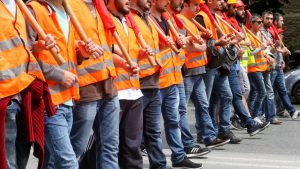Canada has maintained a long and wavering relationship with Canadian Armed Forces (CAF) service members and veterans.
In times of mass military mobilization during the First and Second World Wars, many national programs supported the post-war reintegration and employability of veterans.
While historically veteran programs varied in levels of success, a unifying tenet is that Canadian veterans should be supported when transitioning from volunteering to defend the nation to full reintegration into society.
When soldiers, sailors and aviators enroll in military service, they forego many opportunities, such as working in civilian industry, pursuing education or harnessing their entrepreneurial spirit.
Recently, Canadian veterans have been benefitting from a resurgence of awareness and support from the federal and provincial governments, industry and fellow citizens.
Properly harnessed, they can disproportionately impact the construction industry, whether as skilled tradespersons, supporting the construction sector or business owners.
Through the arc of time, we have witnessed federal government support for veterans evolving from land grants in the 19th century to robust education and training benefits today; however, it can be argued the approach can be viewed as inconsistent.
Today, Veterans Affairs Canada, established in 1944, is the lead federal department responsible for supporting veterans and their families.
Veterans Affairs Canada estimates there are just over 610,000 veterans in Canada and Statistics Canada suggests this number is nearly 500,000. While an accounting discrepancy exists, we know hundreds of thousands of veterans are employed today.
Annually, over 5,000 service members leave the military, where almost 65 per cent are employed after leaving the CAF.
Stated differently, a highly trained and experienced work-ready population is underexplored.
There is an immediate opportunity for the Canadian skilled trades sector to develop tailored pathways into the construction industry.
Concerning employee shortages, BuildForce Canada has recently stated the “construction sector is on the cusp of a generational shift,” where the implication is that new and innovative sectorial attraction strategies must be explored.
In other words, there is a natural linkage between veterans looking for work and the skilled trades needing new apprentices to fill the labour gap.
For the construction industry, there are many economic benefits from developing and investing in a credible veteran-hiring program; benefits include supporting veterans, families and the attention from doing so responsibly.
One of the unique aspects of military service is that CAF service members, whether in the full-time Regular Force or the part-time Reserve, are cross trained in many functional areas.
While there are over 100 occupational specialties (officer or non-commissioned member), service members are trained and educated to fill complementary roles other than their primary combat function.
This may include veterans who have received post-secondary education, language instruction and extensive leadership training.
Regardless of the military environment (army, air force or navy) or military occupation, service members are expected to employ soft skills such as critical thinking, problem-solving, communication, time management and organizational ability.
In aggregate, the implication for the civilian sector is that hiring a veteran will result in a new employee with considerable skills, professional knowledge and a proven record of adaptability and learning.
Nearly 60 per cent of Regular Force personnel in Canada are in a domestic partnership.
This translates to almost 35,000 spouses. For a transitory population that is expected to relocate across the country every few years, spouses and partners often face employment challenges.
The impact is not only financial but for some spouses, there are self-doubt implications as family members face a dearth of employment opportunities and are often underemployed. While the economic strength of the family suffers, there is also a negative impact on the well-being of family members.
For the construction industry, there is an opportunity to recognize that a resilient, self-manageable and committed pool of employee prospects exists in your local area.
While many spouses put their careers on hold to support their uniformed loved ones, the skilled trades sector can encourage this population to apply for positions through an innovative approach.
The outcome will see engaged employees contributing to the growth of local industry, the economy and independent businesses.
Nationally, few organizations have recognized the undeveloped talent of CAF service members, veterans and their families.
This large, geographically dispersed group will provide tangible and intangible value to the skilled trade industry.
For the past decade, Helmets to Hardhats has successfully referred veterans to the skilled trades.
There is now an opportunity for the construction industry to consider further the implications of developing tailored hiring programs.
For the skilled trades sector, biases or misunderstandings may surround veterans’ skills and lived experience; however, this can be addressed by collaborating with organizations such as Helmets to Hardhats and Release Point Education.
Dr. Darryl G. Cathcart is an education consultant and founder of Release Point Education. Send Industry Perspectives Op-Ed comments and column ideas to editor@dailycommercialnews.com.











Recent Comments
comments for this post are closed